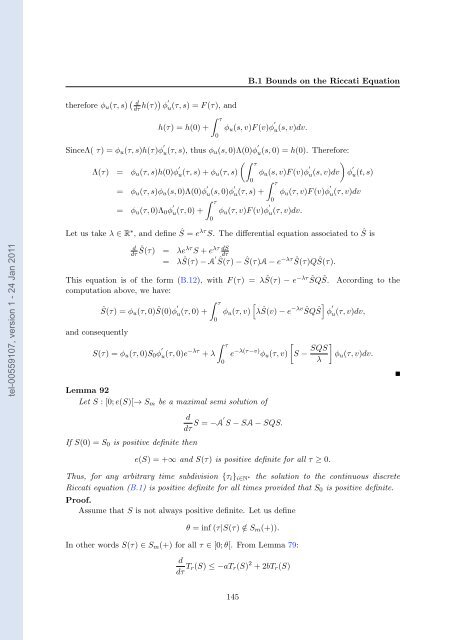Adaptative high-gain extended Kalman filter and applications
Adaptative high-gain extended Kalman filter and applications
Adaptative high-gain extended Kalman filter and applications
Create successful ePaper yourself
Turn your PDF publications into a flip-book with our unique Google optimized e-Paper software.
tel-00559107, version 1 - 24 Jan 2011<br />
therefore φu(τ,s) � d<br />
dτ h(τ)� φ ′<br />
u(τ,s)=F (τ), <strong>and</strong><br />
� τ<br />
h(τ) =h(0) +<br />
SinceΛ( τ) =φu(τ,s)h(τ)φ ′<br />
u(τ,s), thus φu(s, 0)Λ(0)φ ′<br />
0<br />
B.1 Bounds on the Riccati Equation<br />
φu(s, v)F (v)φ ′<br />
u(s, v)dv.<br />
Λ(τ) =<br />
u(s, 0) = h(0). Therefore:<br />
φu(τ,s)h(0)φ ′<br />
�� τ<br />
u(τ,s)+φu(τ,s) φu(s, v)F (v)φ<br />
0<br />
′<br />
�<br />
u(s, v)dv φ ′<br />
=<br />
u(t, s)<br />
φu(τ,s)φu(s, 0)Λ(0)φ ′<br />
u(s, 0)φ ′<br />
� τ<br />
u(τ,s)+ φu(τ,v)F (v)φ<br />
0<br />
′<br />
=<br />
u(τ,v)dv<br />
φu(τ, 0)Λ0φ ′<br />
� τ<br />
u(τ, 0) + φu(τ,v)F (v)φ ′<br />
u(τ,v)dv.<br />
0<br />
Let us take λ ∈ R ∗ , <strong>and</strong> define ˆ S = e λτ S. The differential equation associated to ˆ S is<br />
d<br />
dτ ˆ S(τ) = λeλτ S + eλτ dS<br />
dτ<br />
= λ ˆ S(τ) − A ′ S(τ) ˆ − S(τ)A ˆ − e−λτ S(τ)Q ˆ S(τ). ˆ<br />
This equation is of the form (B.12), with F (τ) = λ ˆ S(τ) − e−λτ SQ ˆ S. ˆ According to the<br />
computation above, we have:<br />
ˆS(τ) =φu(τ, 0) ˆ S(0)φ ′<br />
� τ �<br />
u(τ, 0) + φu(τ,v) λ ˆ S(v) − e −λv �<br />
SQ ˆ Sˆ<br />
φ ′<br />
u(τ,v)dv,<br />
<strong>and</strong> consequently<br />
S(τ) =φu(τ, 0)S0φ ′<br />
u(τ, 0)e −λτ � τ<br />
+ λ<br />
Lemma 92<br />
Let S : [0; e(S)[→ Sm be a maximal semi solution of<br />
If S(0) = S0 is positive definite then<br />
0<br />
0<br />
e −λ(τ−v) �<br />
φu(τ,v) S − SQS<br />
�<br />
φu(τ,v)dv.<br />
λ<br />
d<br />
S = −A′ S − SA − SQS.<br />
dτ<br />
e(S) =+∞ <strong>and</strong> S(τ) is positive definite for all τ ≥ 0.<br />
Thus, for any arbitrary time subdivision {τi}i∈N∗ the solution to the continuous discrete<br />
Riccati equation (B.1) is positive definite for all times provided that S0 is positive definite.<br />
Proof.<br />
Assume that S is not always positive definite. Let us define<br />
θ = inf (τ|S(τ) /∈ Sm(+)).<br />
In other words S(τ) ∈ Sm(+) for all τ ∈ [0; θ[. From Lemma 79:<br />
d<br />
dτ Tr(S) ≤−aTr(S) 2 +2bTr(S)<br />
145

















